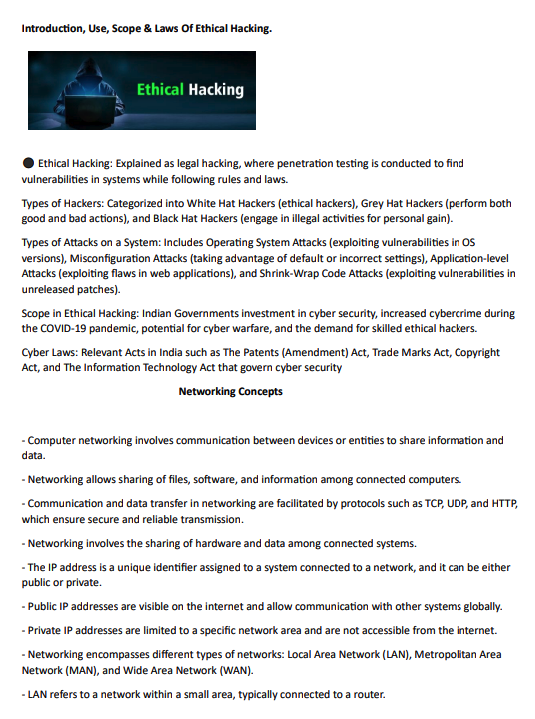Hacking Full Course – Ethical Hacking
Summary:
The text overviews ethical hacking, its types, scope, and relevant laws. It explains that ethical hacking involves conducting legal penetration testing to identify system vulnerabilities. The types of hackers are categorized as white hat (ethical), grey hat (perform both good and bad actions), and black hat (engage in illegal activities). Different types of attacks on systems are discussed, including operating system attacks, misconfiguration attacks, application-level attacks, and shrink-wrap code attacks. The scope of ethical hacking is explored, mentioning factors such as government investment in cybersecurity, increased cybercrime during the COVID-19 pandemic, the potential for cyber warfare, and the demand for skilled ethical hackers. Cyber laws, including relevant acts in India, are mentioned as governing cybersecurity practices.
The second part of the text focuses on networking concepts. It explains that computer networking involves communication between devices to share information and data. Networking allows for sharing of files, software, and information among connected computers. The text delves into various aspects of networking, including protocols such as TCP, UDP, and HTTP, IP addresses (public and private), types of networks (LAN, MAN, WAN), IPv4 and IPv6, ports and their states, and the significance of ports in facilitating communication and data transfer between systems.
The text briefly introduces the OSI and TCP/IP models, explaining their functions and layers. The OSI model has seven layers, while the TCP/IP model has four layers. The differences between the two models are highlighted, along with their common principles and concepts.
Excerpt:
Hacking Full Course – Ethical Hacking
Introduction, Use, Scope & Laws Of Ethical Hacking.
Ethical Hacking: Explained as legal hacking, where penetration testing is conducted to find
vulnerabilities in systems while following rules and laws.
Types of Hackers: Categorized into White Hat Hackers (ethical hackers), Grey Hat Hackers (perform both
good and bad actions), and Black Hat Hackers (engage in illegal activities for personal gain).
Types of Attacks on a System: Includes Operating System Attacks (exploiting vulnerabilities in OS
versions), Misconfiguration Attacks (taking advantage of default or incorrect settings), Application-level
Attacks (exploiting flaws in web applications), and Shrink-Wrap Code Attacks (exploiting vulnerabilities in
unreleased patches).


Reviews